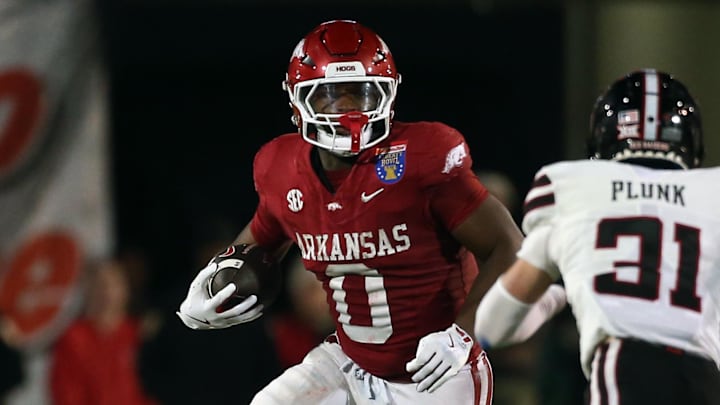College athletics has been through a turbulent few years, marked by the combination of the transfer portal and NIL. Now, the NCAA enters another revolutionary era: revenue sharing. Friday, U.S. Judge Claudia Wilken signed off on the latest House V. NCAA settlement proposal, codifying revenue sharing into law. But what does that mean for Arkansas athletics?
How the House Settlement affects Arkansas
The House settlement indeed greenlights revenue sharing, but it does much more than that. Ross Dellenger of Yahoo Sports produced an excellent X (formerly Twitter) thread on what's being affected post-House V. NCAA. In addition to allowing for over $20 billion in revenue sharing, the settlement establishes a new enforcement arm, sets roster rules, and provides back pay for former athletes. More importantly, it effectively ends colligate amateur sports for good.
$2.8B in back-pay:
— Ross Dellenger (@RossDellenger) June 7, 2025
- spread over 10 years
- from NCAA + school distribution (NCAA Tournament money)
- distribution determined using a formula based on a player’s value
- $2.3B goes to P4 FB/MBB players (avg of $120K a player over 10 years)
- Back-payments begin soon
Back payments
Over the next 10 years, ex-athletes from Arkansas will receive back payments, with the majority of those payments going to football and men's basketball players. The average payout is around $120,000 spread out over a decade, but what Dellenger doesn't explicitly state in his X thread is which athletes are eligible for back payments. Individuals who played between 2016 and 2024 are eligible, which means some of the most important athletes in Arkansas football history, like Darren McFadden or Jarius Wright, won't see a dime.
The NCAA will use a formula to calculate the value of players and distribute accordingly. However, Dellenger and the ruling isn't clear about how the formula works. Since 2018, the transfer portal has muddied up the waters when it comes to value.
One example that hits close to home is KJ Jefferson. At Arkansas, he was extremely valuable, breaking multiple quarterback records as a Razorback. But he fell off the face of the Earth once he transferred to UCF. However, does the NCAA calculate his value? Is it based on his most valuable seasons, or is the most current season weighted more heavily? Or is it just an average of all six of his seasons?
Determining fair compensation is a challenging task, which may explain the lack of a clear beginning. Dellenger doesn't provide a specific date for when payments will start, only stating that they'll begin soon.
Revenue sharing
On the other hand, revenue sharing has a set date. Current athletes can start receiving payments as early as July 1. However, rev-sharing isn't mandatory, and schools can opt out if they disagree with certain aspects of the House Settlement.
Arkansas, like all other schools, will have a $20.5 million cap that can be distributed at the school's discretion. However, Title IX rules still apply, so Dellenger suggests that potential lawsuits could follow.
Here's where collegiate athletics effectively turns into pro sport. To share revenue, universities will often buy the NIL rights of their athletes. In addition to outright purchasing NIL rights, any booster-related NIL deals over $600 will go through a third-party clearinghouse, a firm called Deloitte. It will assess the 'fair market value' of athletes and approve or deny any non-school-related deal. For Arkansas, that essentially means the days of being out-bid in NIL are over.
Rosters structure
Not all of the $20.5 million salary cap goes directly toward revenue sharing. Scholarships and Alston pay ($5 million total) count toward the cap now that the entire roster can receive a scholarship, but not everyone on the roster has to be given a scholarship.
Arkansas football will most likely be one of those programs that still takes walk-ons, not because of financial issues, but because the walk-on has a very special place in the heart of the football program. Names like Brandon Burlsworth and Grant Morgan wouldn't have had a chance if it weren't for the program, and head coach Sam Pittman isn't willing to let that go.
"I don’t want to lose the walk-on status of our kids," Pittman said when asked about the then proposed roster limits. "I think it’s important, especially in our state, to have walk-ons from your state on the team."
Speaking of the rosters limits, the new limit for each of the major sports have all gone up. Football will grow from 85 to 105. Basketball now has 15 roster spots, and baseball has the largest jump from 11.7 to 34.
Enforcement
The last few years have been called 'The Wild West' era of college athletics due to virtually no enforcement from the NCAA on things like tampering and NIL. But with the House V. NCAA Settlement, the NCAA is taking some of that power back.
In addition to the third-party auditor, Deloitte, it's created a 'cap management system' with the plaintiffs, Power Four conferences, and the NCAA working together to ensure the rules of the settlement are followed. This will require schools to submit regular reports documenting their compliance. Anytime there's an appeal, the case will be heard by a neutral arbitrator.
